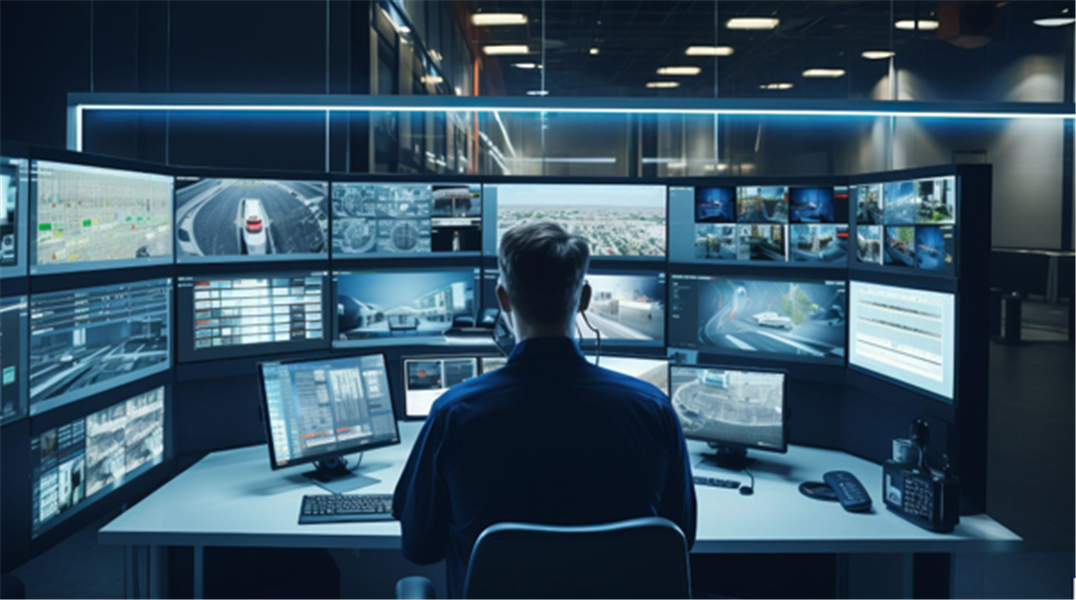What is remote video monitoring, and how does it work?
Is theft or vandalism impacting your operations?
Remote video monitoring provides a reliable solution to address these concerns.
A remote video monitoring system utilizes advanced technology to view and record video footage from a remote location, allowing for the early detection and response to suspicious activity. This system offers round-the-clock surveillance, ensuring the protection of people, assets, and company reputation through swift detection and immediate action.
In addition to preventing theft and vandalism, remote video monitoring also helps identify accidents, injuries, and disputes in real-time. This article will provide an overview of remote video monitoring functions and its key benefits.
Definition of remote video monitoring
Remote video monitoring is a one-of-a-kind security solution, combining advanced AI-powered camera detection with fast response from trained remote operators.
With remote video monitoring, any threats detected by the security camera system automatically trigger video alarms at the connected command center. There, trained security professionals promptly access live video feeds in real time, ready to respond and take appropriate action.
Components of a remote video monitoring system :
CCTV Cameras: High-definition cameras capture live video feeds, offering features such as night vision, motion detection, and wide-angle views. Equipped with advanced video analytics, these CCTV cameras provide robust detection capabilities.
Horn Loudspeakers: Proactive deterrents that issue verbal warnings to intruders in real-time, helping to prevent incidents before they escalate.
Recording Equipment: Digital video recorders (DVRs) or network video recorders (NVRs) that securely store footage, often utilizing cloud storage for easy access and backup.
Remote Monitoring Center: A team of trained security operators who monitor feeds in real-time, responding to alerts or suspicious activity.
Alarm Systems: Integrated systems that trigger alerts when motion is detected or alarms are activated, notifying the monitoring center and sending alerts directly to you.
Access Control Systems: Features like keycard entry or biometric scanners that limit access to your property, providing an additional layer of security.
User Interface: An easy-to-use interface accessible via smartphones, tablets, or computers, allowing you to view live feeds, receive alerts, and manage settings from anywhere.
How does remote video monitoring work?
Let’s break down how remote video monitoring keeps property secure step by step.
Step 1: Strategic placement of cameras and loudspeakers
The process begins with proper security device placement. The initial step is to identify key areas such as entry points, high-value zones, hallways, lobbies, cash registers, and storage rooms. These locations are critical for installing cameras and horn loudspeakers. The objective is to achieve comprehensive coverage, eliminating blind spots and maximizing security effectiveness.
It's best to consult a professional security integrator for this crucial task.
Step 2: Triggering video alarms
After installation, the cameras continuously monitor the designated areas, capturing live video feeds. The CCTV system is designed to trigger alerts sent to the remote monitoring center based on a range of detected activities, including:
● Intrusions inside the monitored perimeter
● Specific license plates
● Tailgating by humans and/or vehicles
● Loitering
● Shoplifting gestures
● Smoke and fire
● Slip and fall incidents
● Violence
● Brandished guns
● And much more
Step 3: Response by trained operators
As soon as the alarm is triggered at the remote video monitoring center, the diligent operators access the live video feeds. They analyze the footage to assess the situation and confirm if the threat is real.
Step 4: Swift action and escalation
If a threat is confirmed, operators immediately start following your established SOPs, which may involve voice interventions via on-site loudspeakers, contacting the owner or the security manager of the property, alerting local authorities like the police, fire department, or dispatching security agents.
Step 5: Vigilance until resolution
Even after the initial response, the operators keep a close watch on the situation until the threat is fully resolved or authorities arrive on-site. They maintain constant communication to provide real-time updates and coordinate efforts. The footage of the incident is securely stored, most often in the cloud, so it’s always accessible for review and analysis.
By implementing these measures, high-quality live remote video monitoring services turn your property into a secure stronghold, ready to respond to any threat immediately. This level of protection offers invaluable peace of mind.
To conclude remote video monitoring integrates a CCTV surveillance system with a professional third-party monitoring service, providing real-time oversight and elevated security.
This seamless combination ensures constant surveillance, immediate response to incidents, and remote access to live feeds from anywhere, keeping your property secure 24/7.
Secure your property now, explore remote video monitoring solutions and experience unmatched protection today!
 Back to news & articles
Back to news & articles